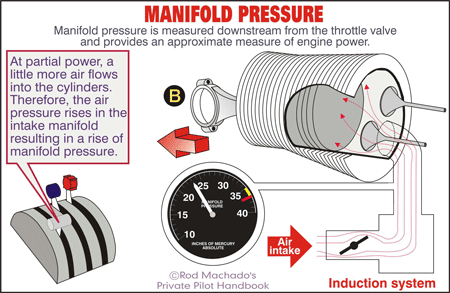Manifold Absolute Pressure or MAP for short is the amount of charge pressure entering the engine cylinders. You will see manifold gauges mainly in aircraft with variable pitch propellers where the throttle lever controls the manifold pressure and the propeller lever controls the propeller blade angle. The prop lever very simply controls the engine speed, while the throttles control the amount of power supplied to the engine.
Manifold pressure is measured in between the throttle valve and the intake manifold of the engine cylinders. When the aircraft is parked with engines fully off, the MAP gauge will read the pressure of the aerodrome. In ISA conditions, the gauge will read 29.92 inches of Mercury which is the normal everyday pressure at sea level. If the aircraft is at an aerodrome with a higher elevation, the gauge will read less than 29.92. Once the engines get started and if the throttle is not increased much, the Manifold will fall. This happens because the cylinders keep on taking in air from the intake creating a low pressure in the area. If the throttle is fully idled, the manifold pressure will further drop.
In a normally aspirated piston engine aircraft, the manifold pressure cannot go above the atmospheric pressure (in real life the pressure will be slightly below atmospheric). However, if the aircraft is turbocharged, the engines can supply power at a much higher pressure. A turbocharger consists of a compressor and turbine assembly run by the engine exhaust gases. The gases run the turbine which in turn runs the compressor. The compressor compresses the air and sends this air into the cylinders. This allows the aircraft to climb to higher altitudes without losing power.
The turbocharged engines also lose power as they climb, but the loss is much more less compared to a normal one. For both the turbocharged and normal engines there comes an altitude where the pilot set manifold pressure can no longer be maintained. This altitude is known as the critical altitude. For turbocharged engines this is the point where the turbocharger attains its maximum speed and the waste gate is fully closed. The waste gate is a gate that opens and closes to control the speed of the turbocharger. This does it by expelling excess air into the atmosphere. As it closes, all the exhaust air is directed into the turbine. The opposite is the case when it is fully open.
The operation of an aircraft with both the manifold and RPM gauges are different to those that only have an RPM indicator. When you want to reduce the power, the MAP should be reduced before the propeller RPM. If the RPM is reduced before the manifold pressure, you would be supplying a higher pressure of charge into the cylinders even though the coarsening of the propeller reduced the engine speed. This if done regularly can damage the engine components. The reverse is the case if you want to increase the power. The props should be set first. Then the manifold should be altered.
The amount of fuel provided to the engine depends on the pressure difference between the manifold and the throttle body. The throttle body pressure will decrease as the throttle is increased, because of greater rate airflow across the venturi (faster air -> lower pressure). The manifold pressure will increase as throttle is increased, due to the greater flow of fuel/air mix into the manifold (greater mass of air flowing into a fixed volume -> higher pressure). So the pressure difference will get larger as the throttle is increased.













ليست هناك تعليقات:
إرسال تعليق